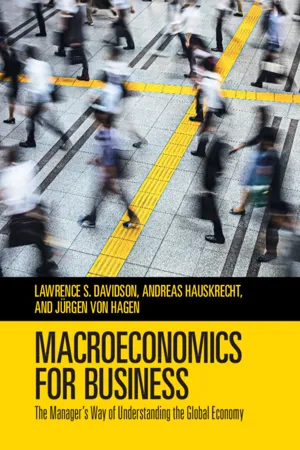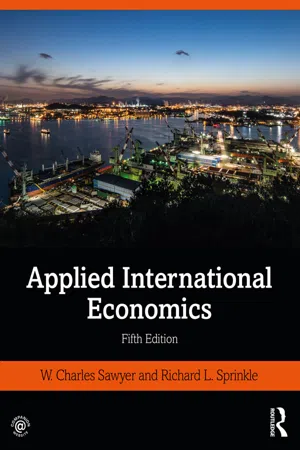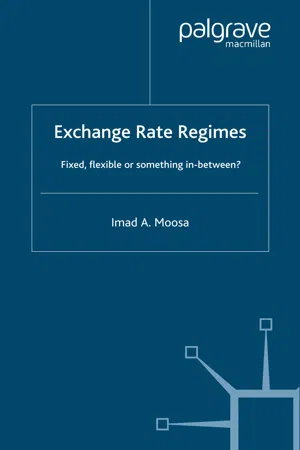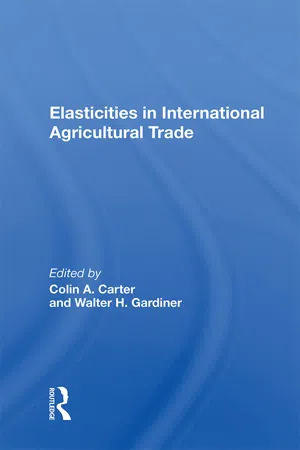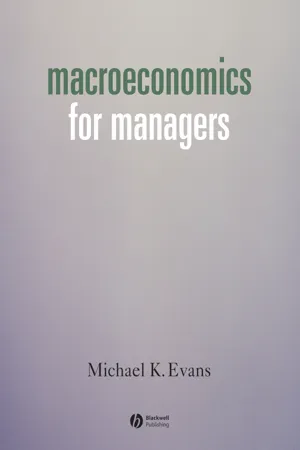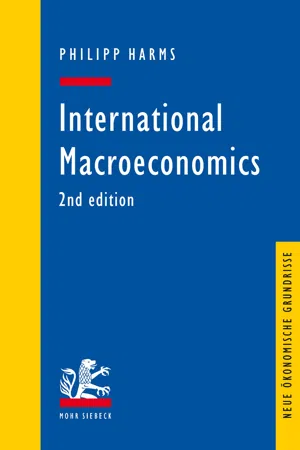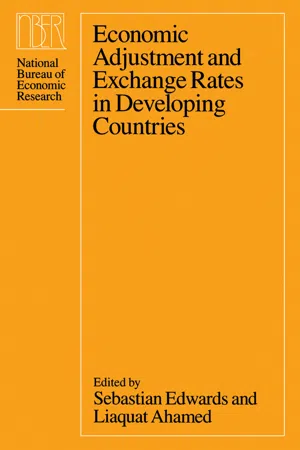Economics
Exchange Rate and Net Exports
Exchange rate refers to the value of one currency in terms of another. Changes in exchange rates can impact a country's net exports, which is the difference between the value of a country's exports and imports. A depreciation of a country's currency can make its exports cheaper for foreign buyers, potentially increasing net exports, while an appreciation can have the opposite effect.
Written by Perlego with AI-assistance
Related key terms
1 of 5
11 Key excerpts on "Exchange Rate and Net Exports"
- eBook - PDF
Macroeconomics for Business
The Manager's Way of Understanding the Global Economy
- Lawrence S. Davidson, Andreas Hauskrecht, Jürgen von Hagen(Authors)
- 2020(Publication Date)
- Cambridge University Press(Publisher)
Imports will decline and the trade deficit shrink. But this means that there are now fewer financial inflows from abroad available to finance 260 International Trade, Exchange Rates, Capital Flows gross domestic investment. Given the increased scarcity of financing, domestic interest rates will rise to attract more foreign capital and this will increase the value of the currency. Exports will fall due to the stronger exchange rate, and investment will fall due to the higher-interest rate. In the end, any reduction in the trade deficit would be bought at the cost of a weakening of the economy. So far, this is not unlike the effects of a reduction of the government budget deficit discussed before. Using trade policy instruments, however, will attract the attention and arouse the ire of foreign governments much more than using domestic policy instruments. Foreign governments will complain against such measures, because they directly affect their own economies, and they may retaliate by imposing quotas and higher tariffs on imports. Again, only small countries can get away with such policies, larger ones would risk international trade conflicts. For more on that, see Chapter 9. In the end, the trade deficit problem comes back to saving and investment. It is hard to escape from this macro fact. 8.5 Exchange Rate Concepts The external value of a currency is measured by the exchange rate of that currency against another currency or other currencies. Exchange rates come in two notations. First, we can say that, for example, 3 Brazilian reals buy USD 1. This quantity or real per dollar notation is the answer to the question: How many units of foreign currency buy one unit of domestic currency? Second, we can say that one-third of a USD buys 1 Brazilian real. - eBook - PDF
- Henk Jager, Catrinus Jepma(Authors)
- 2017(Publication Date)
- Red Globe Press(Publisher)
In Chapter 19 we will discuss recent applications of each of them. Exchange-Rate Systems and Effects 261 14.3 The current account and international trade In any discussion of the effects of exchange rates on international trade, a distinction should be made between a one-off change in the exchange rate and an exchange rate that shows a pattern of volatility over time. The influence of a one-off change of the exchange rate on the value of a country’s international trade flows and hence on its trade balance (i.e., the balance of the goods and services accounts of the balance of payments) will be analysed in Sections 14.3.1 and 14.3.2. The subject of Section 14.3.3 is the effect of exchange-rate volatility. 14.3.1 The absorption approach The exchange rate is a macroeconomic variable par excellence. The starting point for a macroeconomic review of the exchange-rate effect on the trade balance is the income identity, which indicates that a country’s domestic production is made up of various components. Expressed as a formula, this identity is: Y ≡ C + I + G + X − IM , (14.1) where Y is domestic production, C is consumption by residents, I is investment by resi-dents, G is the country’s government spending, and X and IM denote the country’s exports and imports, respectively. All these economic variables are nominal, expressed in terms of domestic currency. The sum of the first three variables on the right-hand side of this identity ( C + I + G ) is also known as total spending by residents or domestic spending; it is also labelled absorption, denoted A . By deducting imports we arrive at residents’ spending on domestic products. If we next add exports – that is, foreign purchases of domestic products – we obtain a figure for the total spending on goods produced in the country. In the statistics for a particular period in the past, this total expenditure on domestic goods will always be equal to domestic production – which explains the identity character of equation (14.1). - eBook - PDF
Macroeconomics
Understanding the Global Economy
- David Miles, Andrew Scott, Francis Breedon(Authors)
- 2014(Publication Date)
- Wiley(Publisher)
500 MACROECONOMICS real exchange rate. However, as we see in Figure 19.13, the real exchange rate is too volatile in the short run to be explained by variations in fiscal policy, savings, investment and so forth. For that reason, in Chapter 20 we will move on to discuss changes in the nominal exchange rate. What we have provided in this chapter, though, is a long-run model with which to consider fluctuations in the nominal exchange rate (PPP) and a medium-run model (where real exchange rates shift to ensure that net savings equals net investment). Our focus in the next chapter will be on short-run fluctuations in the nominal exchange rate. D E F I N I T I O N K E Y P O I N T Fluctuations in net savings and net exports can be used to partially explain why the real exchange rate is so variable compared to the predictions of PPP. However, these fluctuations in economic fundamentals are not large enough or frequent enough to explain more than 3–10-year swings in the real exchange rate. S U M M A R Y In Section 19.1, we defined various concepts of exchange rates. The bilateral exchange rate is the rate at which two particular currencies are exchanged, and the effective exchange rate reflects the behaviour of a currency against a trade-weighted average of all currencies. The nominal exchange rate reflects the rate at which you can swap different currencies, whereas the real exchange rate represents the relative cheapness of one country compared to another. In Section 19.2, we discussed the law of one price: the idea that the same commodity should sell for the same price in all countries due to arbitrage. We showed that there are substantial deviations from the law of one price due, in part, to tariffs and transportation costs, but also due to border effects and pricing to market on the part of firms. In Section 19.3 we applied the law of one price to all commodities by using purchasing power parity. - eBook - ePub
- W. Charles Sawyer, Richard L. Sprinkle(Authors)
- 2020(Publication Date)
- Routledge(Publisher)
CHAPTER 14Exchange rates and their determinationA basic modelThe exchange rate is determined from day to day by supply and demand of home currency in terms of foreign currency. Each transaction is two-sided, and sales are equal to purchases. Any change in the conditions of demand or of supply reflects itself in a change in the exchange rate, and at the ruling rate the balance of payments balances from day to day, or from moment to moment.Joan RobinsonINTRODUCTIONT he international value of a country’s currency has become an inescapable part of the daily flow of economic information. Most of us are aware that a country’s exchange rate is important, but many of us do not have a clear idea of why the exchange rate matters or what causes it to change. As the chapter’s opening quote indicates, the familiar tools of supply and demand analysis can be used to determine a country’s exchange rate. In this chapter, you will learn why the supply and demand model works in analyzing exchange rates—in the same manner, in fact, that it works in analyzing the price of gasoline or pizza, for one dollar or one yen or one gallon of gasoline is indistinguishable from another. By the end of this chapter you should have a good grasp of why exchange rates are important and what factors cause them to change over the long run. Finally, it is obvious to even a casual observer that exchange rates change frequently. These changes, or volatility, are a source of aggravation for individuals, businesses, and governments. The chapter explains what economists know about the effects of exchange rate volatility on international trade and how changes in exchange rates affect the prices of the goods and services we purchase. The final part of the chapter deals with the underlying value of a currency. While the exchange rate we observe in the market often differs from that value, it is very useful to know what that value is.EXCHANGE RATESSuppose that a U.S. importer is purchasing British Jaguars. To purchase the Jaguars, the importer needs to obtain British pounds by exchanging dollars for pounds. The demand for foreign currency is derived from individuals demanding foreign goods and services. This relationship can be applied in reverse. As individuals in the U.K. demand U.S. products, there is an increased demand for dollars. However, this raises the question of how many dollars must be exchanged to obtain the requisite number of pounds, or vice versa? In this example, the relevant exchange rate is the U.S. dollar–U.K. pound exchange rate. In general, the exchange rate is the price of one country’s currency in terms of another. The demand for British pounds relative to the supply of pounds will determine the exchange rate, just as the demand for gasoline relative to the supply of gasoline determines the price of gasoline. Exchange rates fluctuate considerably over time. However, unlike the price of gasoline, changes in the exchange rate are expressed as changes in the value of the domestic country’s currency. An increase in the value of a currency is referred to as appreciation. Analogously, a decline in the value of the currency is referred to as depreciation - eBook - ePub
Macroeconomics
(With Study Guide CD-ROM)
- Jagdish Handa(Author)
- 2010(Publication Date)
- WSPC(Publisher)
Since the exchange markets for financially developed economies tend to be efficient (i.e., go to equilibrium rapidly), the market exchange rate for our economies would tend to be the equilibrium one. However, if the exchange rate has been fixed by the government or the central bank, it might be at the equilibrium level, or above or below the equilibrium level. If it was set above the equilibrium level, the economy would have a balance of payments deficit; if it was set below the equilibrium level, the economy would have a balance of payments surplus.Since both commodity and capital flows are components of the demand and supply of foreign exchange, changes in the net exports of commodities and net capital flows both produce changes in the market exchange rate. In the short term, capital flows are usually more volatile, so that short-term fluctuations in the exchange rate are usually due more to fluctuations in capital flows than in commodity flows.Chapter 12 will further expand on this analysis of the foreign exchange market.Figure 3.1Fact Sheet 3.4 : Exchange Rates against the US Dollar, 1980−20083.9.1 Hot moneyThis Fact Sheet illustrates movements in the exchange rates in terms of the US dollar of the currencies of several countries. Some of these countries had pegged exchange rates for part of the selected period. For example, the decision to peg the national currency to the US dollar was taken by Argentina from 1980 to 1988 and from 1991 to 2001, by Mexico in the early 1990s, by Malaysia after 1997, and by China in 1993. When this peg became unsustainable, they switched to a floating exchange rate. The depreciation experienced after such a switch is evident for Argentina in 1988 and 2001 as well as for Mexico in 1991.Some of the capital flows among countries are extremely sensitive to expected interest and exchange rate changes, as well as to the political and economic insecurity in the country. Speculation about a possible devaluation/depreciation of the domestic currency can cause sudden, heavy outflows of short-term funds seeking protection from it, or trying to make a profit out of it. Funds whose flows among countries are very sensitive to expected exchange rate changes, interest rate fluctuations or security and convertibility (i.e., unhindered exchanges among currencies) considerations are known as hot money. - eBook - PDF
Exchange Rate Regimes
Fixed, Flexible or Something in Between?
- I. Moosa(Author)
- 2006(Publication Date)
- Palgrave Macmillan(Publisher)
2 The Role of the Exchange Rate in the Economy Macroeconomic linkages through exchange rates The exchange rate provides a key macroeconomic linkage between the domestic economy and the rest of the world that takes place through the goods and asset markets. In the goods market, the exchange rate establishes linkages between domestic and foreign prices through the relationship P ¼ þ EP ð2:1Þ where P is domestic prices, P* is foreign prices and the exchange rate is expressed as the domestic currency price of one unit of the foreign currency. The parameters that reflect transaction costs and other market imperfections are and . This is a linear relationship between domes- tic prices and foreign prices expressed in domestic currency terms. It shows that the higher the exchange rate, other things being equal, the higher the price of foreign goods in the home country (@P/@E > 0). The same relationship can be seen in Figure 2.1, which depicts P as a func- tion of P*. As the exchange rate rises (the domestic currency depreciates) the line P ¼ þ EP* rotates upwards, leading to higher P for the same level of P*. This happens either directly (because the domestic price of imported goods rises) or indirectly (because domestic firms can afford to raise their prices when competitors’ prices rise). Some of the effect is transmitted through the labour market, as workers may demand wage increases when higher import prices raise the cost of living. Govern- ments that are aware of this connection would prefer to stop depreci- ation but if they do so in the face of domestic inflation they risk a loss in competitiveness. Naturally, the effect of domestic currency appreciation 29 on domestic prices can be augmented by a rise in foreign currency prices as shown in Figure 2.2. On the other hand, it can be seen in Figure 2.3 that domestic currency appreciation (falling exchange rate) can offset the effect of rising foreign prices. - Colin Carter(Author)
- 2019(Publication Date)
- CRC Press(Publisher)
Exchange Rate and the Value of Trade A traditional question in the macroeconomic trade literature is whether currency depreciation would improve the balance of trade (Goldstein and Khan). According to the elasticities approach, the result depends on the elasticities of demand and supply of exports and imports. When values are expressed in foreign currency the value of imports must decline, but what happens to the value of exports depends on the relative importance of lower prices and greater quantities. When values are expressed in domestic currency, the value of exports necessarily rises (both price and quantity increase), but the value of imports may rise or fall depending on the relative importance of higher prices and lower import volume. If import prices rise faster than export prices, depreciation may be followed by a temporary deterioration of the trade balance. The so-called J curve is a popular representation of this transitory effect. The same general relationship should hold for particular exports or imports as for total trade, except that elasticities should be greater for narrowly defmed products. To the extent that the impact of an exchange rate change on trade depends on the underlying domestic elasticities, it is conditional on domestic agricultural policy. The response of exports to currency depreciation will be smaller if there are production or acreage controls. The effect of binding price supports can be represented by either altering the elasticity of export supply or the elasticity of inventory demand. The dynamic path of adjustment may also be affected by price expectations. For example, lower price supports in the United States were announced in December 1985, but they did not take effect for grain until June-September of 1986. Thus, for the first six months following the announcement prices were expected to decline.- Eckhard Siggel(Author)
- 2016(Publication Date)
- Routledge(Publisher)
The computation of the real exchange rate with the purpose of determining the degree of over- or under-valuation of the currency is important for the policy maker because the real exchange rate is an indicator of how the international competitiveness of economic activities is affected by exchange rate misalignment. Competitiveness can be defined as the ability to sell without making losses, or to produce at unit costs that are lower than those of international competitors. Clearly, international competitiveness is first and foremost a result of high productivity and factor cheapness, which vary from industry to industry. But the exchange rate affects all or most domestic prices relative to foreign prices, and thereby impacts on the competitiveness of all activities. An overvalued exchange rate represents a disincentive to all domestic producers, since it makes imports artificially cheap and lowers the domestic currency price of exports. Inversely, an undervalued exchange rate makes industries internationally competitive, as long as domestic prices do not catch up with world prices and costs. Although the impact of exchange rate misalignment on competitiveness is a temporary phenomenon, it can last for periods of several years. Competitive advantage derived from exchange rate undervaluation is not equal to comparative advantage. While comparative advantage of industries does not disappear with real appreciation of the exchange rate, competitive advantage does. It follows then that policy makers must try to avoid major misalignment of the exchange rate in order to assure stability of economic incentives. In the case of a fixed exchange rate regime overvaluation is eliminated by devaluing the currency and, at the same time, preventing the domestic rate of inflation from exceeding international rates. Let us see now what are the implications of currency devaluation for the economy. Before doing so, however, the reader should be acquainted with one more definition of the real exchange rate, the real effective exchange rate (REER).The REER follows the same principle as the RER, except that it is trade-weighted and expresses the value of a currency in terms of all other currencies that are important in the country's trade relations. Logically, it is also in index form, just like the RERI, as it cannot be expressed in terms of several foreign currencies at the same time. The computation of REER is complex and requires data on the trade flows and prices of many countries. For that reason, even the IMF is unable to publish it for all of its member countries, which are covered in its International Financial Statistics, a monthly and yearly publication and a major source of international trade and financial data.- eBook - PDF
- Michael K. Evans(Author)
- 2008(Publication Date)
- Wiley-Blackwell(Publisher)
In the US, the value of the dollar increased sharply in the late 1990s in spite of an unprecedented increase in the US trade deficit. Currencies of other industrialized countries, such as the UK, Germany, and Japan, depend largely on the expected rates of return on financial and real assets, but the current account balance does influence the value of those currencies. 464 THE INTERNATIONAL ECONOMY The currency values of small countries with weak or nonexistent financial markets depend almost entirely on their current account balances. In the medium run (one to five years), assuming that the central bank is not trying to manage the value of the currency, the following ceteris paribus conditions hold. The value of the currency will rise if: • Ex ante investment exceeds ex ante domestic saving • The rate of return of financial assets increases • The rate of return on equities and tangible assets rises • The rate of inflation declines • The current account balance increases. These conditions are symmetrical; the value of the currency will decline if the reverse conditions occur. The smaller the country, the more important the rate of inflation and current account balance become, and the less important the gap between investment and saving and the relative rates of return on assets. Throughout this discussion we have emphasized that comparative rates of return are calculated in real terms; i.e., adjusted for the expected rate of inflation. Hence the following asset groups are all in relative terms. Thus, for example, to determine the value of the dollar, the appropriate interest rate is its performance in the US compared to the performance in other major countries. Keeping this in mind, these are the major factors that are likely to influence the values of exchange rates. 1. Short-term riskless debt assets in real terms. In practice, this is often estimated by taking the nominal difference in interest rates, treating the relative rate of inflation as a separate term. - eBook - PDF
- Harms, Philipp(Authors)
- 2016(Publication Date)
- Mohr Siebeck(Publisher)
27 Recall from (7.22) that, if the law of one price holds for all goods, variations in the terms of trade directly affect the real exchange only if there is a home bias in consumption. 28 Note that we are sidelining an even bigger conceptual question – namely, whether an economy’s “competitiveness” is actually reflected by its ability to export more than it imports. 29 The GDP deflator is the ratio of nominal GDP over real GDP, with the latter measuring domestic output at constant prices. Its level thus reflects the prices of all goods and services produced in an economy, including investment goods. VII.5 The Real Exchange Rate and Net Exports 299 (7.28) H PPI t F PPI t t PPI t P P E Q , , For some applications, finally, it may be more appropriate to capture a country’s cost competitiveness by computing real exchange rates based on countries’ unit labor costs (ULC) . Unit labor costs are determined by dividing a country’s total wage sum by real GDP. Accordingly, the ULC-based real exchange is given by (7.29) H t H t H t F t F t F t t ULC t Y L W Y L W E Q with i t W denoting the average nominal wage, i t L denoting total employment, and i t Y denoting real GDP in country i (with F H i , ). Defining average labor productivity in country i as the ratio of GDP over employment, i.e. i t i t i t L Y A / , and using lower-case letters to denote (natural) logarithms, we can transform the expression in (7.29) into (7.30) H t H t F t F t t ULC t a w a w e q A real depreciation – i.e. an increase of the ULC-based real exchange rate – thus occurs if domestic wage increases are less pronounced than domestic productivity increases (both relative to the foreign country). In Figure 7.9, we depict the evolution of the CPI-based , GDP deflator-based and ULC-based real effective exchange rate for the Euro area. It strikes the eye that, despite the very different definitions and conceptual underpinnings, the three time series largely move in parallel. - Sebastian Edwards, Liaquat Ahamed, Sebastian Edwards, Liaquat Ahamed(Authors)
- 2007(Publication Date)
- University of Chicago Press(Publisher)
(See Dornbusch 1984 and the refer- ences cited there for an analysis of these systems.) Dual exchange rate systems are usually designed so that the current-account rate is fixed or determined by a crawling peg, while the capital-account rate is al- lowed to be determined by market forces. The effect, indeed the pur- pose, of such a system is to control the extent of private international capital flows, with the differential between the capital-account and the current-account exchange rates measuring the effective rationing price of whatever net amount of foreign exchange is allowed to become available for financing private capital flows. 2.7 The Combined Effects of Monetary and Exchange Rate Policy An especially important mechanism through which economic policies affect the real exchange rate and thereby replicate some of the effects of commercial policies is through the interaction of monetary policies and policies designed to influence the nominal exchange rate. To ana- 71 Commercial, Fiscal, Monetary, and Exchange Rate Policies lyze the implications of this combination of policies, it is necessary to broaden the model introduced in the earlier sections by introducing appropriate monetary elements. The condition for equilibrium in the domestic money market is expressed by the requirement: (40) m = k + p* + e + fq - ED’(e), where m denotes the logarithm of the nominal money supply; k sum- marizes the exogenous factors affecting the logarithm of the demand for domestic money; e denotes the logarithm of the nominal exchange rate (defined as the price of a unit of world money in terms of domestic money); p* denotes the logarithm of the world money price of traded goods; 1 > 0 is the elasticity of money demand with respect to the relative price of domestic goods: and > 0 is the semielasticity of money demand with respect to the expected rate of change in the nominal exchange rate.
Index pages curate the most relevant extracts from our library of academic textbooks. They’ve been created using an in-house natural language model (NLM), each adding context and meaning to key research topics.
